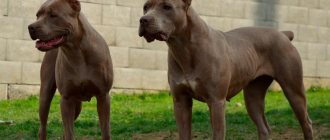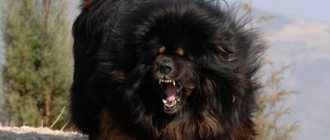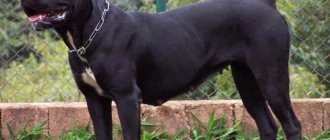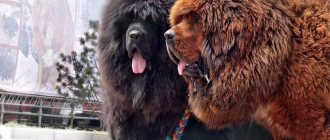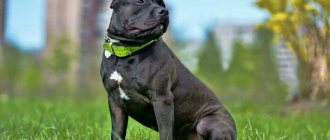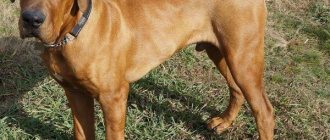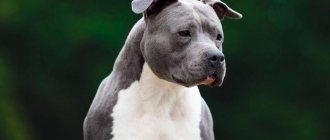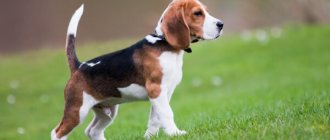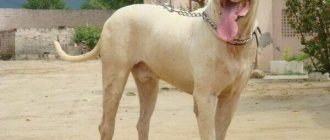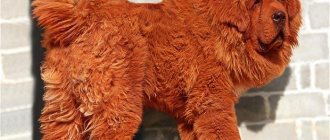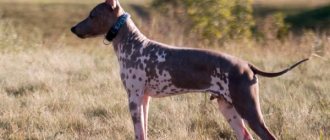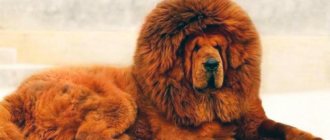One of the results of this race for the ideal was the American Bandog - a ferocious but incredibly charming dog.
The roots of this American breed, like all Americans, lie in old Europe. “Bandog” is a collective image of a dog that sleeps quietly on a chain during the day, and at night goes out on patrol around the entrusted territory of a large house. Not a single thief will pass through, not a single stranger will encroach on the house of his precious owner. Of course, these were most often mastiff mixes with another large breed - stability of health, ferocity, loyalty and protective qualities were valued.
Breed characteristics
| Short description | |
| Origin: | USA |
| Conditions of detention: | In a house with a large surrounding area |
| Purpose: | Sentry, security |
| Color: | Black, red, brown, gray, may have spots |
| Wool length: | Short |
| Adult dog size: | Height: 63-75 cm (females are slightly lower) Weight of males - 45-63 kg, females - from 38 kg |
| Average life expectancy: | 10-15 years |
| Walk: | 2-3 times a day, one of the walks is at least 1 hour |
| Physical activity needs: | High needs |
| Fédération Cynologique Internationale (FIC) classification: | Not recognized |
| Puppy price: | from 20,000 to 70,000 rubles, on average about 50,000 rubles. |
Pros and cons of the breed
The popularity of the American Bandog breed is not at the highest level. It is recommended to purchase a puppy from nurseries with a good reputation. The nature of the Bandog is complex, so first, study all the features of keeping and raising such a dog, evaluate your strengths and capabilities, and only then go for a puppy.
Below are the main pros and cons of the Bandoggy breed.
Advantages:
1. Intelligence, intelligence. 2. Endurance, strength. 3. Fearlessness. 4. Excellent guard and security qualities. 5. Easy care. 6. Good health.
History of the origin of the species
The first mention of the name "bandog" occurs in the Middle Ages in England. Then it did not denote a specific breed, but a large, terrifying-looking, molossoid-type dog. The term “bandog” itself translated means “chain dog”.
There are 2 versions regarding its origin:
- Dogs of this type were kept on a chain and only released at nightfall to guard the territory.
- The animals were too excited before the fight to be restrained by the ropes, so they were secured with steel links.
At that time, dogs were used to fight bulls and other dogs, as well as to protect homes and livestock. They could force a stray animal to return, and also scare away badgers, foxes, and wolves.
The appearance and origin of the bandogs of those times were varied; no clear exterior standards were established.
In the 60s of the 20th century, the American veterinarian John Swinford decided to resurrect the breed, relying on working qualities rather than exterior. One of the first dogs of his selection was Bantu, obtained from an American pit bull terrier and a female English mastiff. The father of a representative of the new breed, named Swinford's Bandog, was tested in the "pit" (a dog fighting venue in the USA).
The veterinarian's task was to create the ideal combination of the power and strength of a mastiff with the energy, excitement and endurance of a pit bull terrier (or amstaff). He was unable to finish the work, however, after his death, friends and supporters continued it.
At the moment the breed is not recognized by the FCI and many other associations. The formation is not yet complete, representatives of different species are used for selection, so the appearance of the bandogs is also slightly different. Typically, puppies are obtained from a union of pit bull terrier, amstaff, and mastiff.
Development proceeds in 3 directions, with the predominance of blood from one of the breeds:
- Basics . A combination of Staffordshire or Pitbull with dogs of the Mastiff group. A Bandog should have between 25 and 75% Amstaff or APBT blood.
- Secondary . The predominance of mastiff blood ( from 25 to 75% ).
- Tertiary . Rarely used, but possible. Up to 75% of the genotype comes from the following breeds: Boerboel, Dogue de Bordeaux, bull terrier, American bulldog, Tosa Inu, Fila Brasileiro, bullmastiff, Dogue de Canary, Cane Corso.
Description
The dogs were bred for a specific personality, phenotype, to be domestic guard dogs and personal bodyguards, as well as powerful fighters in the “pit.” The Bandog is a very strong, massive dog with a powerful skeleton and extraordinary muscles, terrifying and merciless when angry and extremely active. She requires constant attention and education. Breeders still cross Bandogs with other breeds and develop more and more new types of Bandogs. The main quality of Bandogs is excellent health and watchdog qualities. The main combinations for breeding are the fearlessness and tenacity of the American Pitbull Terrier and the large size and guarding instinct of the Mastiff.
Distinctive features
Bandoggie inherits characteristics characteristic of its parents. Therefore, dogs from different kennels differ from each other.
In general, the breed is characterized by the following features:
- The head is massive, with a visible stop. The muzzle is elongated, not narrowed.
- The nose is often black and well developed.
- The eyes are small, slanted, located far from each other, the iris is dark in color.
- The neck is powerful, muscular, and of medium length.
- The ears are drooping and usually cropped into a triangular shape.
- The tail is of standard length, tapered to the tip, hangs down when calm, and never curls over the back.
- The body is strong, with developed muscles, massive bones, the back is straight. The chest is very wide and deep, the ribs are pronounced, the stomach is tucked.
- The legs are of medium length, heavy-boned, strong, well-defined.
- The coat is hard, straight, and short in length. Almost any color, but a pure white shade is undesirable. There are usually light markings on the legs.
Photo of an adult dog
Photos of puppies
Features of character and behavior
Representatives of the breed are distinguished by:
- Activity;
- Energy;
- Devotion to the owner;
- High security capabilities;
- Distrust of strangers.
Advantages
- Representatives of this breed are born watchdogs and have a pronounced territorial instinct.
- Dogs are fearless and will defend theirs to the last.
- They carefully monitor strangers, analyze their behavior and make sure to stop all unwanted actions. Although, most often, one frightening appearance of an animal is enough to eliminate thoughts of attack or theft. Despite the formidable exterior, with proper upbringing the dog is quite balanced and does not show unmotivated aggression towards strangers.
- They are devoted to the owner, strive to please him , unlike other representatives of working and guard dogs, they do not try to dominate. They usually treat other family members evenly; they can get along with children, but they will not tolerate intrusiveness and disrespect towards them.
- Bandogs study everything new with interest, love to play, and are trainable. Dogs of this breed are silent and rarely speak, especially without reason. They have a high pain threshold, dexterity, high intelligence, can intuitively determine a person’s intentions, and often develop a line of behavior on their own.
Flaws
- Bandoggies will find it difficult to tolerate being around other animals, especially those of equal size. Living with cats and dogs is only possible if they were raised together from childhood.
- A pronounced protective instinct, in the absence of education, can result in aggression towards strangers, uncontrollability and imbalance, which, combined with some willfulness in decision-making and the large size of the dog, can lead to negative consequences.
- Before an attack they do not bark in warning, they attack immediately.
- Lack of physical and intellectual stress will lead to destruction in the house, nervousness of the animal and increased excitability. Therefore, it is important to give the dog an outlet for energy.
- Due to their physique and the characteristics of the central nervous system, representatives of the breed quickly become excited, violently attack an intruder or other animal, but are capable of maintaining this level of activity for a short time. Then the dogs get tired and their engagement levels drop.
- Bandog is stubborn and self-willed; he will not do what he does not like and will not tolerate rough treatment. When raising children, you need to be firm and find a special approach.
Owner reviews
Larisa Gennadievna
I have been selling my American Bandog for 1 year. There are documents. Healthy. Knows all the commands. Very playful and agile. There is no way to contain it. And especially walking. He runs around like crazy. Very powerful. I'm a pensioner and I can't keep him on a leash. But my son lives in another place and cannot take him for a walk.
Sergey
I advise you to think ten times before starting a bandog. We took all kinds of courses, but the dog never became completely obedient. Often makes attempts to catch passers-by. Apparently, he feels fear and hatred of his own species from them. Sometimes he rushes towards running children, seemingly with playful intentions. But I never let him go. When necessary, we go out into the street only wearing a muzzle and wearing a “strict coat.” If we are going for a long walk, then we go out of town, and only there do I take off the muzzle. Before Bandog I had a boxer, a Rottweiler and even a mastiff, so I have something to compare with. If you live in an apartment, like me, then trust my experience and give up the idea of getting such a dog.
Anonymous
Just finding Bandog in Russia is a big problem!
Tanya
very good dogs, I have been keeping two male Bandogs for three years now and am very pleased with them!!!!!!
Tani4chka_Yusi4ka
Hello. My mother had this dog. He was simply gorgeous... And they are not always evil... This one was kind...
JAF83
Perversion of breeds, that's what it's called! My subjective opinion - pitas separately - mastiffs separately! Why reinvent the wheel - there are - there are bulldogs - bullmastiffs - canaries - Bordeaux - corso - there are a lot of large “scary” purebred dogs! I honestly don’t like Ben Dog (or my friend American Bullie)!
Video
Care and maintenance
The breed does not require special care, it has fairly good health and a coat that does not cause problems. It is advisable to keep the dog in a house with a large surrounding area to provide it with the opportunity to fully walk. In the warm season, living in a spacious enclosure is suitable. In winter, a bandog cannot be kept outside.
Dogs' nails are trimmed as needed, usually once a month. It is better to brush your teeth and check your ears and eyes once a week.
Nutrition
Bandoggies are prone to gastrointestinal problems, so all new foods should be introduced gradually and the pet’s reaction should be monitored. They can be fed professional food or natural food with plenty of protein.
Ready-made dry or canned food must be classified as premium or super-premium and labeled “for large breed dogs.” It is better to choose a manufacturer based on the reaction of the pet’s gastrointestinal tract, as well as the condition of the dog’s coat and activity after consuming it.
Natural food can be represented by lean meats, offal, fermented milk products, grains, and vegetables.
It should be taken into account that food allergies often occur to wheat porridge and baked goods.
You also need to pay attention to the development of the bandog’s skeletal system; due to its large size, it may be necessary to include vitamins with calcium in the diet.
A two-month-old baby is fed 6 times a day , by six months the number of meals is reduced to 3 , and at 10 months. transferred to the routine of an adult dog and fed twice a day .
We recommend that you read a detailed article on the topic: “How and what to feed a dog: types and characteristics of nutrition.”
Health
The health of pets of this breed is generally good, however, there is a predisposition to some diseases of the skeletal system and eyes, as well as to gaining excess weight.
Vaccinations
When vaccinating Bandog, you can follow the usual schedule.
7 days before vaccination you need to carry out deworming, and for puppies immediately after the injection, quarantine for 2 weeks, exclude walking during this time and monitor their health status.
Vaccination is carried out only on healthy animals. Timely vaccination will protect your pet from the following diseases:
- Plague;
- Trichophytosis;
- Parovirus enteritis;
- Coronavirus;
- Hepatitis;
- Leptospirosis;
- Parainfluenza;
- Rabies.
Vaccinated with a complex vaccine. Intervals may vary slightly depending on the drug, but you can adhere to the following scheme:
- 8 weeks – vaccination with a drug labeled DHPPiL;
- quarantine;
- 12 weeks – vaccination with a drug labeled DHPPiL + R;
- quarantine.
Adult animals are vaccinated once a year.
Important article on the topic: “Everything you need to know about dog vaccinations.”
Diseases
Bandoggs are in good health, but they are predisposed to certain diseases:
- Dysplasia of the hip and elbow joints . The disease is congenital and is not immediately detected. It begins with limited movement, refusal to climb stairs, wagging croup, and can lead to absolute immobilization. Veterinarians recommend at the age of 15 months. Take an x-ray of the dog so as not to miss the development of pathology.
- , glaucoma, retinal atrophy, and cataracts may appear .
- Problems with the gastrointestinal tract - disorder, food allergies, gastritis, gastric volvulus.
- Epilepsy . It occurs more often in females and manifests itself in the form of convulsive attacks of a neurological nature, resulting from congenital disorders of brain functioning.
- Like Amstaffs and pit bulls, Bandoggies have a risk of developing tumor processes, including cancer .
Walk
Bandogs need to be walked 2-3 times a day, one of the walks should be at least an hour. Walking should be active, with running, exercise, and games. To release energy, following a bicycle, roller skates, frisbee, swimming, walking with weights (not at a young age) is suitable. To develop the joints and metacarpus, you can use walking on pebbles.
Grooming
The bandog's coat is short and does not require grooming. Once a week, using a brush for short-haired breeds or a special glove, you need to walk over the coat to remove dead hair.
You should rarely bathe your dog if it is very dirty. In other cases, you can rinse the animal with warm water or wipe the fur with a soft cloth.
Health
The average lifespan of an American bandog is 12-16 years.
This is a naturally healthy breed with strong immunity. Health problems in most cases arise due to improper maintenance, care, and nutrition.
You can avoid many diseases if you undergo annual preventive examinations with your dog at a veterinary clinic. It is important to carry out vaccination, deworming and treatment against skin parasites on time.
It is easier and faster to treat any disease in the initial stage. Therefore, it is important to monitor your dog's behavior. If her activity decreases, her appetite disappears, her coat becomes dull, you should consult a veterinarian. Since such symptoms usually signal a disease.
The owner of a Bandog should know what diseases the breed is predisposed to:
- Obesity occurs as a result of overfeeding.
- Epilepsy – characterized by convulsions and seizures.
- Joint dysplasia – accompanied by pain, lameness, and immobility.
- Oncological diseases.
- Eye diseases - cataracts, progressive retinal atrophy.
Mating
The first mating is carried out no earlier than 2 years. It can be difficult to choose a partner; the breed is recognized by very few associations, and accordingly, the origin of many animals is difficult to establish.
It is better to contact trusted nurseries whose lines will be of interest to improve the parameters of a particular dog. The nearest Bandog breeders are located in Ukraine, Germany and Greece.
If an animal is used that is not from a nursery, then it is imperative to check its pedigree and exhibition achievements. Parents must match the breeds of one of the 3 existing areas of selection.
The female and male must demonstrate excellent health and be free of genetic diseases. Partners must be treated for helminths before mating; this is prohibited during pregnancy. Mating is usually carried out on the male’s territory, 2-3 times with a break of 24 hours. After this, you can expect the appearance of offspring.
Read a detailed article on the topic: “Everything you need to know about breeding dogs: appropriate age, what to do if it doesn’t work out, rules and tips.”
Price and reviews of bandog
Before buying a puppy, you should definitely study the pet's pedigree. This is important for mental stability and potential training results. Bad heredity can make keeping a dog dangerous for both the owner and the people around him. The price for a Bandog is about the same as for a Bull Terrier, about $300.
It is not difficult to purchase a fighting dog in the homeland of the bred breed. are not very common in Russia Reviews from owners indicate the strength and reliability of dogs, provided they are properly raised and maintained.
Key points in training
Bandogs are smart and love to learn.
Education and training should begin from the moment the baby appears in the house, since an adult animal that is not adapted to society can be dangerous.
The person conducting the training must have a strong character. If the owner is a beginner and is not familiar with raising serious dogs, it is better to turn to a professional.
The dog can master both the OKD and ZKS courses; in the USA, representatives of the breed serve in law enforcement agencies. Training should take place in a playful way, using treats and praise. Pets of this breed will not tolerate rough treatment or the use of force.
If the animal is stubborn, you should change the method of influence. It is necessary to ensure that any command given is carried out so that the authority of the owner always remains unquestioned.
Read about how to properly train a dog in the article: “Training a puppy: effective methods from dog handlers, learning commands at home.”
Raising an American Bandog
Raising an American Bandog puppy should be done from early childhood. If you do not have experience in communicating with dogs of this kind, then it is best to immediately go with your puppy to an experienced dog breeder and begin to learn how to find a common language with the dog and become an authority for it.
As we have already said, if you cannot become a real pack leader for your dog or decide to show your authority through punishment or physical force, then it may well be that all those scary stories that you read in the newspapers about fighting dogs will become for you or passers-by who meet on your way, reality. We repeat once again that raising a dog needs to be done very seriously and best under the supervision of an experienced dog handler. You should not rely on the stories of friends who know and can do everything, you should not listen to their advice, even if they had such a dog.
Remember that every dog is an individual, every dog has its own thoughts in its head, its own character, and stubbornness. Moreover, this applies not only to such dogs, but to all breeds in general. You can listen to advice, take it into account, yes, but you should not follow advice unquestioningly. Only an experienced and certified dog handler can correctly tell you which approach to take with your dog.
How to choose a puppy
To purchase a Bandoggy puppy, the future owner will have to contact breeders in the USA, Greece, Germany, Slovakia or Ukraine. There are no nurseries in Russia; it will be difficult to guarantee the origin of puppies. Each breeder has his own direction of selection, the dogs, accordingly, differ in appearance. The future owner can choose an exterior option that is close to him.
Before purchasing, you need to make sure that both parents are healthy, have pedigrees and veterinary passports with vaccination records, it is also advisable to observe their behavior and study their character. The selected puppy must be active, not shy, inquisitive, and without signs of disease.
Bandog is a breed for active people who know how to handle guard dogs and are willing to spend time and effort on walking, training and education. In return, the pet will protect its owner and his property, and will give loyalty and affection.
5 / 5 ( 2 voices)
Temperament and training
An adult dog can scare you with just its appearance.
Like all strong dogs, training for bandogs is very important. Only proper upbringing allows you to raise an intelligent and reliable dog.
Key points in training
Strict discipline is very important. The owner must be adamant in everything. Moreover, even puppies should not be given any slack - they very quickly get used to it and begin to test people’s strength.
For reference! Despite their fighting purpose, bandogs get along well with other dogs, as well as cats and other pets.
It is very important to show the dog from an early age who is boss in the family. All means are good for this, including thrashing. Either the bandog has recognized its owner as a leader since childhood, or in the future it will cause a lot of problems for everyone around it.
Attitude towards children
This dog is clearly not suitable for families with children. No, she cannot be called overly aggressive. But a noisy child who constantly climbs everywhere will obviously not find approval from the dog. Therefore, leaving them alone together is definitely not worth it.
